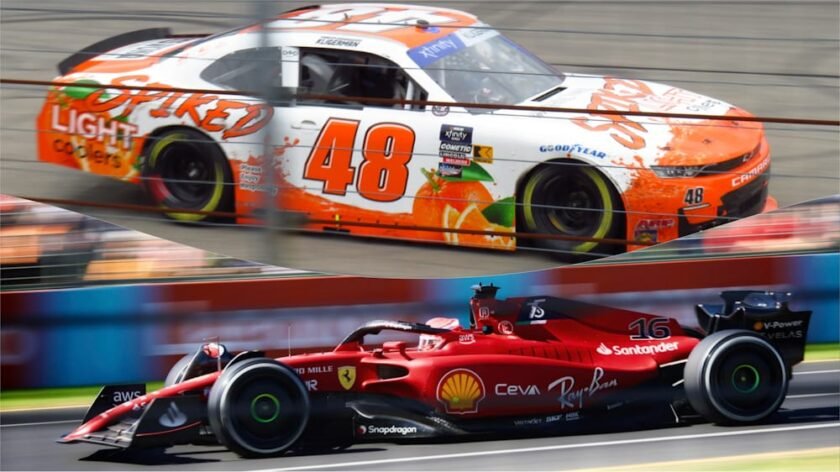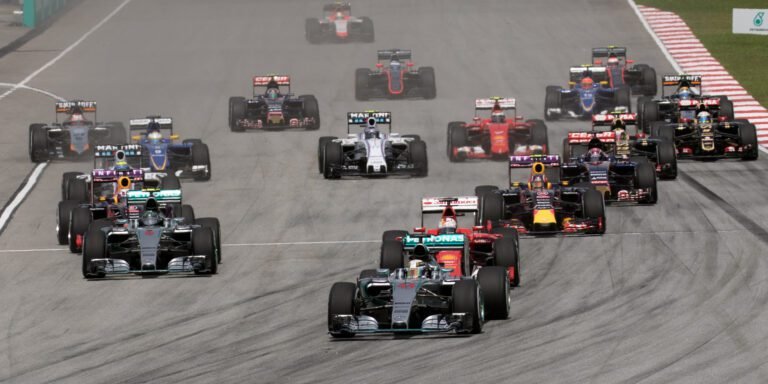Formula 1 vs NASCAR: Key Differences, Speed, Popularity, and Challenges
- Key Differences Between Formula 1 and NASCAR
- Speed: Formula 1 vs NASCAR
- Popularity: What Is Bigger, Formula 1 or NASCAR?
- Sound: Which Is Louder, Formula 1 or NASCAR?
- Difficulty: Which Is Harder, Formula 1 or NASCAR?
- Financial Comparison: Who Makes More Money, Formula 1 or NASCAR?
- Evolution: How Have Formula 1 and NASCAR Changed Over Time?
- Conclusion
- FAQ
Motorsports enthusiasts are no strangers to the rivalry between Formula 1 (F1) and NASCAR—two of the most exciting and popular racing series worldwide. While both deliver fast-paced, adrenaline-filled action, the two are vastly different in numerous ways, from speed and car design to race formats and the cultures that surround them. In this article, we’ll explore what sets these motorsport giants apart, diving into their technical aspects, global appeal, and unique challenges, while addressing some of the most common questions that fuel the debate.
Key Differences Between Formula 1 and NASCAR
Racing Format
Formula 1 takes racing to a global stage, with events held across diverse and iconic circuits in countries like Monaco, Silverstone, and Suzuka. These tracks are known for their complexity, featuring sharp corners, steep elevation changes, and tight chicanes that demand drivers’ utmost precision. The strategic nature of Formula 1 races adds another layer of intrigue—teams plan meticulously for factors such as tire wear, fuel management, and shifting weather conditions. In this high-stakes environment, every millisecond can make the difference between victory and defeat.
In contrast, NASCAR is firmly rooted in the U.S., where the majority of its races take place on oval tracks. While these tracks might appear simpler at first glance, they require a completely different kind of strategy. NASCAR races focus on endurance, with drivers maintaining high speeds for extended periods—sometimes upwards of 3 to 4 hours. Although the technical challenges of the tracks are less demanding than in F1, the close-quarters, pack racing style of NASCAR introduces its own unique intensity. Drivers must maintain laser focus and exceptional physical and mental stamina to thrive in this environment.
| Formula 1 tracks | NASCAR tracks |
|---|---|
| Global circuits, complex and varied | Oval circuits, endurance-based |
Cars and Technology
The differences between Formula 1 and NASCAR are perhaps most evident in the cars themselves, which reflect the distinct priorities and philosophies of each series.
Formula 1 cars are marvels of modern engineering, designed with cutting-edge aerodynamics at the forefront. Each car features a hybrid engine that combines internal combustion with electric components, delivering staggering power while maintaining a lightweight structure. Precision is key in F1, where even the slightest design tweak can drastically affect performance. The focus on reducing drag, maximizing downforce, and optimizing cornering speed makes these cars extremely specialized, resulting in machines that are not only fast but also incredibly agile on complex, high-speed tracks.
In contrast, NASCAR vehicles are built with durability in mind, designed to withstand the physical demands of close-quarter racing. Powered by powerful V8 engines, these cars deliver substantial horsepower, but their design prioritizes strength and resilience over cutting-edge aerodynamics. NASCAR cars are engineered to endure aggressive contact with other vehicles, which is a common occurrence on oval tracks. While the technological sophistication of F1 cars pushes the boundaries of innovation, NASCAR’s emphasis on reliability and robustness ensures that its vehicles are built to handle the rigorous, often rough-and-tumble nature of its racing style.
| Formula 1 cars | NASCAR cars |
|---|---|
| Lightweight, hybrid-powered, focus on aerodynamics | Heavy, V8 engines, built for endurance and durability |
Race Structure
The structure of Formula 1 and NASCAR races offers a striking contrast, shaped by the unique demands of each series.
Formula 1 races are typically shorter, lasting around two hours, with the number of laps varying based on the track’s length. These races are as much about strategy as they are about speed. Teams must constantly balance tire wear, fuel consumption, and car performance, making every decision—whether it’s when to pit or how to adjust settings—vital to securing a win. The relatively shorter duration of F1 races means that every second counts, and the outcome is often determined by precise planning and execution.
In contrast, NASCAR races are much longer, often covering distances of 500 miles or more, which translates into races lasting upwards of 3 hours. With hundreds of laps to navigate, drivers must sustain high levels of focus and endurance over an extended period. Pit stops are equally crucial in NASCAR, but here they go beyond tire changes and refueling. Mechanical adjustments are frequently made during the race to adapt to evolving conditions, allowing teams to fine-tune their cars for optimal performance as the race progresses. This aspect adds another layer of complexity to NASCAR, highlighting the endurance and adaptability required to succeed.
| Formula 1 races | NASCAR races |
|---|---|
| Shorter, highly strategic races | Longer, endurance-based races |
Fan Base
The fan bases for both sports are distinct, shaped by geography and culture. Formula 1 has a truly global audience, with fervent followings in Europe, Asia, South America, and recently, the U.S. The global nature of the sport lends itself to a diverse crowd, often seen as more upscale and cosmopolitan.
NASCAR is deeply rooted in American culture, especially in the Southern U.S., where it’s seen as a weekend tradition for families. The fan culture revolves around the idea of tailgating, community gatherings, and a more hands-on, accessible form of racing. It’s viewed as less glamorous and more of an everyman’s sport compared to the luxury and exclusivity often associated with Formula 1.
Speed: Formula 1 vs NASCAR
Top Speeds Comparison
When it comes to sheer speed, Formula 1 reigns supreme. F1 cars can reach mind-boggling speeds of up to 230 mph on straightaways, thanks to their advanced hybrid engines and precision-engineered aerodynamic designs. These machines excel not only in straight-line speed but also in high-speed cornering, where the downforce generated by their wings and chassis allows for unparalleled control. The ability to navigate tight corners at high speeds demands extraordinary precision from drivers, a defining characteristic of Formula 1 racing.
NASCAR cars, while not quite as fast in terms of top speed, still hold their ground on the track. Reaching speeds of around 200 mph, especially on longer oval circuits like Daytona or Talladega, NASCAR cars are built to maintain high speeds for longer periods. Unlike F1, where bursts of speed are matched with complex cornering, NASCAR’s strategy revolves around endurance and consistency. Drafting and pit stop strategies become crucial, as drivers work together to stay competitive, emphasizing the importance of maintaining a high pace throughout the duration of the race.
| Category | Formula 1 top speed | NASCAR top speed |
|---|---|---|
| Top Speed | ~231 mph (372 km/h) | ~200 mph (322 km/h) |
| 0–60 mph | ~2.6 seconds | ~3.4 seconds |
| Cornering | Extreme grip | More reliant on throttle |
Impact of Tracks
The design and layout of the tracks significantly influence how both Formula 1 and NASCAR cars perform, shaping the nature of each series.
Formula 1 races take place on a variety of tracks, each with its own challenges. These circuits feature complex layouts that require frequent deceleration and acceleration, meaning F1 cars rarely maintain top speed for extended periods. Iconic tracks like Monaco and Singapore, known for their narrow and winding paths, emphasize precision over raw speed. The focus shifts to mastering tight corners and maintaining control, making these races a test of driver skill as much as car performance.
In contrast, NASCAR’s oval tracks are designed with speed in mind. The relatively simple layout allows drivers to sustain high speeds over long stretches with minimal braking, making endurance and speed consistency key to success. This design gives NASCAR a unique character, where the ability to maintain pace for hours, often in close quarters with other cars, becomes just as important as the sheer speed on the straights.
Popularity: What Is Bigger, Formula 1 or NASCAR?
Global Audience
When it comes to global reach, Formula 1 takes the lead. With races spanning five continents and broadcast in over 150 countries, F1 boasts a truly international following. Countries such as Italy, Japan, and Brazil regard Formula 1 as a national event, and the sport’s fan base continues to grow, particularly in the U.S., where Netflix’s Drive to Survive has played a key role in boosting interest.
NASCAR, on the other hand, remains predominantly a North American phenomenon. While it enjoys immense popularity in the United States, especially in the southern states, its international presence is limited. However, NASCAR’s domestic strength is undeniable, with millions of fans tuning in for marquee events like the Daytona 500—one of the most-watched sporting events in the U.S. Despite its narrower geographical reach, NASCAR commands a loyal and passionate fan base that continues to make it a major force in motorsport.
| Formula 1 audience | NASCAR audience |
|---|---|
| Global sport with massive international audience | Primarily U.S.-based fanbase, regional appeal |
Social Media and Digital Presence
Formula 1 has embraced the digital age with remarkable success. Its social media presence is vast, with drivers and teams frequently engaging with fans across platforms like Twitter, Instagram, and TikTok. This active interaction has helped F1 connect with a younger, tech-savvy audience, ensuring the sport remains relevant and vibrant in a rapidly evolving digital landscape.
NASCAR, while also present on social media, hasn’t quite achieved the same level of engagement, especially among younger fans. Its digital strategy is particularly strong on Facebook, where it maintains a solid following, but NASCAR faces challenges in reaching a broader international audience. Expanding its digital footprint and resonating with global fans remain key hurdles for the sport as it looks to grow its presence beyond North America.
| Formula 1 digital presence | NASCAR digital presence |
|---|---|
| Global sport with massive international audience | Primarily U.S.-based fanbase, regional appeal |
Sound: Which Is Louder, Formula 1 or NASCAR?
The sound of a racing engine is an iconic part of the motorsport experience, and this is where NASCAR and Formula 1 differ significantly.
NASCAR’s thunderous V8 engines produce a deep, guttural roar that resonates throughout the track. With 40 cars racing in close quarters, the noise is constant and intense, often reaching ear-splitting levels. For fans attending a NASCAR event, earplugs are almost a necessity to protect against the overwhelming sound.
Formula 1, especially since the introduction of hybrid engines in 2014, has adopted a higher-pitched, less invasive engine note. While the sound of an F1 car at full throttle is still exhilarating, it no longer carries the same ear-shattering intensity it once did. The shift to hybrid technology has quieted the sport somewhat, a change that has received mixed reactions from long-time fans who miss the raw power of the older, louder engines.
Noise Levels
NASCAR races are renowned for their deafening volume, with the V8 engines producing a deep, low-frequency roar that resonates through the stands. The sound is a visceral, chest-rumbling experience that is inseparable from NASCAR’s identity. Due to its intensity, ear protection is often recommended for fans attending these events, as the noise can be overwhelming.
Formula 1, on the other hand, has seen a noticeable reduction in noise levels since the introduction of hybrid engines in 2014. While the high-pitched sound of F1 cars remains distinctive and thrilling, it no longer carries the same intensity it did during the era of naturally aspirated V10 engines. The shift has led to mixed reactions among fans, but the quieter sound still retains a unique charm, albeit less thunderous compared to NASCAR’s roar.
| Formula 1 sound | NASCAR sound |
|---|---|
| More high-pitched, quite sound | Raw V8, loud sound |
| Up to 150 dB | Up to 130 dB |
Fan Experience
At a NASCAR event, the noise is a key element of the thrill. The relentless roar of the engines, combined with the high-speed action on oval tracks, creates a sensory overload that envelops the crowd. The sound of cars racing by, the vibrations in the stands, and the collective energy of the fans all come together to offer an intense, high-octane race-day experience. For NASCAR fans, the noise is an inseparable part of the spectacle.
In contrast, Formula 1 offers a different kind of sensory experience. While the sound of the cars may be quieter than in previous years, F1 races captivate fans with their blend of high-speed precision, complex strategy, and cutting-edge technology. The cars’ quieter engines are part of a larger spectacle that includes sophisticated engineering, tactical decisions, and a global stage. F1 fans are drawn not just by the noise, but by the entire atmosphere, where every race unfolds like a high-stakes chess match at breakneck speeds.
Difficulty: Which Is Harder, Formula 1 or NASCAR?
Driving Techniques
The difficulty of Formula 1 versus NASCAR is rooted in the unique challenges each sport presents to its drivers.
Formula 1 drivers must master a variety of technical skills, from navigating tracks with tight corners to managing dramatic elevation changes and unpredictable weather conditions. The cars themselves generate immense downforce, allowing drivers to corner at incredibly high speeds. To maintain control, precision and lightning-fast reflexes are essential. The complexity of an F1 circuit leaves little room for error, requiring constant focus and adaptability.
NASCAR, while offering a different kind of challenge, also demands high levels of skill. Drivers often engage in close, high-speed racing on oval tracks, where maintaining control while in tight packs requires intense concentration and situational awareness. NASCAR vehicles are designed to withstand contact, but that doesn’t make the racing any less demanding. The real test lies in the physical endurance required to race for hours at high speeds while simultaneously managing tire wear, fuel levels, and race strategy. The emphasis on consistency and long-term strategy makes NASCAR a unique challenge in its own right.
Physical and Mental Strain
Both Formula 1 and NASCAR place immense physical and mental demands on their drivers, though the challenges they face are distinct.
In Formula 1, drivers endure extreme G-forces, particularly when navigating tight corners at high speeds. These forces can be comparable to what fighter pilots experience, making core strength, neck endurance, and overall physical conditioning essential for F1 drivers. Beyond the physical strain, F1 races require acute mental focus. Drivers must constantly manage tire degradation, fuel levels, and adjust car settings on the fly, all while maintaining a high level of precision. The mental load is intense, as every decision can impact the outcome of the race.
NASCAR, on the other hand, doesn’t subject drivers to the same level of G-forces, but the physical and mental endurance required is still considerable. NASCAR races can stretch over 3 to 4 hours, demanding constant focus and alertness. Drivers must maintain high speeds while managing tire wear, fuel consumption, and navigating tight packs of competitors. The continuous proximity of other cars adds a layer of intensity, as drivers must stay sharp to avoid contact and make strategic decisions over the course of the race. While both forms of racing demand peak physical and mental conditioning, the specific challenges vary—F1 focuses on precision and high-speed maneuvering, while NASCAR is all about endurance and sustained concentration.
Financial Comparison: Who Makes More Money, Formula 1 or NASCAR?
Drivers’ Earnings
When it comes to earnings, Formula 1 drivers typically earn more than their NASCAR counterparts, with the highest-paid F1 drivers raking in tens of millions of dollars annually. Elite drivers like Lewis Hamilton and Max Verstappen can make upwards of $40 million per year in salary alone, not to mention significant income from endorsement deals and brand partnerships. These deals with luxury brands and high-profile sponsors elevate their total earnings, placing them among the highest-paid athletes globally.
NASCAR drivers, while still earning impressive salaries, generally make less than their F1 peers. Top drivers such as Kyle Busch and Denny Hamlin can earn several million dollars annually, but the financial structure in NASCAR tends to be different. NASCAR drivers’ earnings often rely more heavily on team performance and personal endorsements, as the sponsorship model in NASCAR is typically more focused on the teams themselves rather than individual drivers. Despite this, NASCAR drivers still manage to earn substantial amounts, especially when factoring in endorsements and race winnings.
Team Budgets
Formula 1 teams operate with substantially larger budgets compared to their NASCAR counterparts. The top F1 teams, such as Mercedes, Red Bull, and Ferrari, typically spend over $400 million annually. These budgets cover car development, research, technology, staffing, and the continuous push for innovation. While cost caps have been introduced to maintain some level of financial parity, the financial power of top teams still plays a major role in determining success on the track.
NASCAR teams, by contrast, operate with significantly smaller budgets. A typical NASCAR team’s annual budget ranges from $15 million to $30 million, depending on the size of the team and the sponsorship deals in place. The more standardized nature of NASCAR’s car designs means that less money is directed toward technological innovation, which helps keep the competition closer. However, NASCAR teams still rely heavily on sponsorships to cover their operational expenses and ensure that they remain competitive throughout the season.
Evolution: How Have Formula 1 and NASCAR Changed Over Time?
Technological Advancements
Formula 1 has consistently led the way in automotive technology, with each season bringing new innovations. Recently, the sport has embraced sustainability, with hybrid engines now the standard. These engines combine electric motors with traditional internal combustion, significantly reducing fuel consumption and emissions. F1 teams continue to push the boundaries of aerodynamics, using advanced tools like wind tunnels and computational fluid dynamics (CFD) to enhance car performance, focusing on efficiency and speed.
NASCAR, traditionally slower to adopt cutting-edge technology, has also made notable strides in recent years. The introduction of the Next Gen car in 2022 marked a major shift, bringing improvements such as independent rear suspension, sequential gearboxes, and larger wheels. These changes have enhanced both the safety and performance of the cars, making races more competitive. While NASCAR’s technological advancements remain less sophisticated than those of Formula 1, they reflect the sport’s ongoing evolution and commitment to improving the overall racing experience.
Regulatory Shifts
Both Formula 1 and NASCAR have made crucial regulatory changes to enhance safety and address environmental concerns.
In Formula 1, the push for sustainability has led to stricter regulations on car design. Hybrid engines are now standard, and F1 has set an ambitious goal to achieve carbon neutrality by 2030. On the safety front, innovations like the Halo device, which protects the driver’s head in the event of a crash, have become mandatory, underscoring F1’s commitment to improving driver protection.
NASCAR, following a series of high-profile accidents in the early 2000s, has made significant strides in improving safety. The introduction of the Car of Tomorrow (CoT) in 2007, along with advancements in barrier technology, greatly enhanced the safety of the cars and tracks. While NASCAR’s primary focus has been on safety, the sport is gradually turning its attention to sustainability, with initiatives like the introduction of ethanol-blended fuels aimed at reducing its environmental footprint.
Conclusion
While Formula 1 and NASCAR may appear vastly different at first glance, both provide electrifying racing experiences that keep fans hooked. Whether it’s the global appeal and technological sophistication of F1 or the raw, thrilling intensity of NASCAR’s close-quarters racing, each sport offers something truly unique.
Ultimately, the debate over which is superior comes down to personal preference. Armed with insights into the core differences between these motorsports, you can now form your own opinion. Both F1 and NASCAR boast rich histories, dedicated fanbases, and unforgettable racing moments. Whichever you choose to follow, there’s no doubt that the excitement and passion surrounding both sports make them a captivating spectacle for all.
FAQ
Which is faster, Formula 1 or NASCAR?
Formula 1 cars are faster, reaching speeds of up to 230 mph, while NASCAR cars top out around 200 mph. However, NASCAR focuses more on maintaining speed over long distances.
Who has a larger fanbase, Formula 1 or NASCAR?
Globally, Formula 1 has a larger fanbase due to its international presence. NASCAR, while hugely popular in the U.S., has a more regional appeal.
Which racing series pays drivers more, Formula 1 or NASCAR?
Top Formula 1 drivers tend to earn more than their NASCAR counterparts. F1 stars like Lewis Hamilton can make over $40 million a year, whereas top NASCAR drivers earn several million but generally less than F1 drivers.
Which racing series is harder, Formula 1 or NASCAR?
Both Formula 1 and NASCAR present unique challenges. F1 requires precision and the ability to handle complex tracks, while NASCAR focuses on endurance and the ability to maintain speed over long distances.
How has technology changed in Formula 1 and NASCAR?
Formula 1 has adopted hybrid engines and advanced aerodynamics, leading the way in technological innovation. NASCAR has made safety improvements and introduced new car designs with the Next Gen model, but lags behind F1 in terms of technology.







